Parabolas with Vertices Not at the Origin
Learning Objectives
- Identify and label the vertex, axis of symmetry, focus, directrix, and endpoints of the focal diameter given the equation of a parabola in standard form
- Find the equation of a parabolic shaped object given dimensions
A General Note: Standard Forms of Parabolas with Vertex (h, k)
The table summarizes the standard features of parabolas with a vertex at a point [latex]\left(h,k\right)[/latex].| Axis of Symmetry | Equation | Focus | Directrix | Endpoints of focal diameter |
| [latex]y=k[/latex] | [latex]{\left(y-k\right)}^{2}=4p\left(x-h\right)[/latex] | [latex]\left(h+p,\text{ }k\right)[/latex] | [latex]x=h-p[/latex] | [latex]\left(h+p,\text{ }k\pm 2p\right)[/latex] |
| [latex]x=h[/latex] | [latex]{\left(x-h\right)}^{2}=4p\left(y-k\right)[/latex] | [latex]\left(h,\text{ }k+p\right)[/latex] | [latex]y=k-p[/latex] | [latex]\left(h\pm 2p,\text{ }k+p\right)[/latex] |
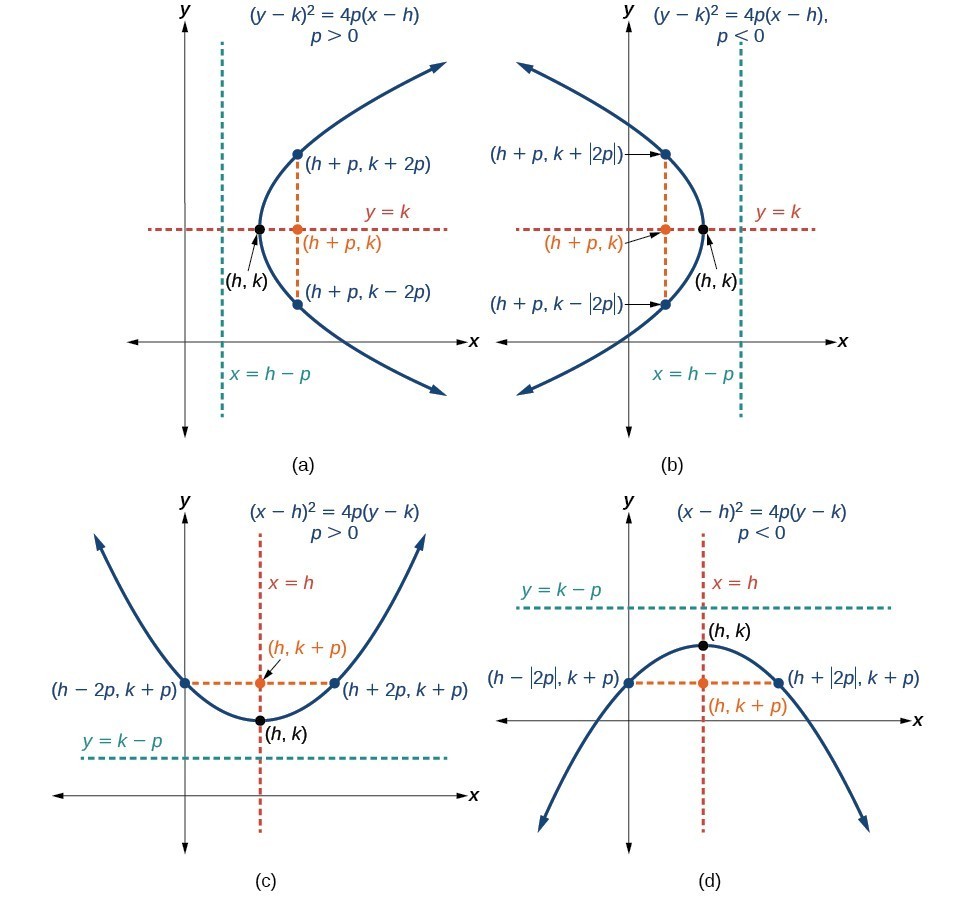 (a) When [latex]p>0[/latex], the parabola opens right. (b) When [latex]p<0[/latex], the parabola opens left. (c) When [latex]p>0[/latex], the parabola opens up. (d) When [latex]p<0[/latex], the parabola opens down.
(a) When [latex]p>0[/latex], the parabola opens right. (b) When [latex]p<0[/latex], the parabola opens left. (c) When [latex]p>0[/latex], the parabola opens up. (d) When [latex]p<0[/latex], the parabola opens down.How To: Given a standard form equation for a parabola centered at (h, k), sketch the graph.
- Determine which of the standard forms applies to the given equation: [latex]{\left(y-k\right)}^{2}=4p\left(x-h\right)[/latex] or [latex]{\left(x-h\right)}^{2}=4p\left(y-k\right)[/latex].
- Use the standard form identified in Step 1 to determine the vertex, axis of symmetry, focus, equation of the directrix, and endpoints of the focal diameter.
- If the equation is in the form [latex]{\left(y-k\right)}^{2}=4p\left(x-h\right)[/latex], then:
- use the given equation to identify [latex]h[/latex] and [latex]k[/latex] for the vertex, [latex]\left(h,k\right)[/latex]
- use the value of [latex]k[/latex] to determine the axis of symmetry, [latex]y=k[/latex]
- set [latex]4p[/latex] equal to the coefficient of [latex]\left(x-h\right)[/latex] in the given equation to solve for [latex]p[/latex]. If [latex]p>0[/latex], the parabola opens right. If [latex]p<0[/latex], the parabola opens left.
- use [latex]h,k[/latex], and [latex]p[/latex] to find the coordinates of the focus, [latex]\left(h+p,\text{ }k\right)[/latex]
- use [latex]h[/latex] and [latex]p[/latex] to find the equation of the directrix, [latex]x=h-p[/latex]
- use [latex]h,k[/latex], and [latex]p[/latex] to find the endpoints of the focal diameter, [latex]\left(h+p,k\pm 2p\right)[/latex]
- If the equation is in the form [latex]{\left(x-h\right)}^{2}=4p\left(y-k\right)[/latex], then:
- use the given equation to identify [latex]h[/latex] and [latex]k[/latex] for the vertex, [latex]\left(h,k\right)[/latex]
- use the value of [latex]h[/latex] to determine the axis of symmetry, [latex]x=h[/latex]
- set [latex]4p[/latex] equal to the coefficient of [latex]\left(y-k\right)[/latex] in the given equation to solve for [latex]p[/latex]. If [latex]p>0[/latex], the parabola opens up. If [latex]p<0[/latex], the parabola opens down.
- use [latex]h,k[/latex], and [latex]p[/latex] to find the coordinates of the focus, [latex]\left(h,\text{ }k+p\right)[/latex]
- use [latex]k[/latex] and [latex]p[/latex] to find the equation of the directrix, [latex]y=k-p[/latex]
- use [latex]h,k[/latex], and [latex]p[/latex] to find the endpoints of the focal diameter, [latex]\left(h\pm 2p,\text{ }k+p\right)[/latex]
- If the equation is in the form [latex]{\left(y-k\right)}^{2}=4p\left(x-h\right)[/latex], then:
- Plot the vertex, axis of symmetry, focus, directrix, and focal diameter, and draw a smooth curve to form the parabola.
Example: Graphing a Parabola with Vertex (h, k) and Axis of Symmetry Parallel to the x-axis
Graph [latex]{\left(y - 1\right)}^{2}=-16\left(x+3\right)[/latex]. Identify and label the vertex, axis of symmetry, focus, directrix, and endpoints of the focal diameter.Answer: The standard form that applies to the given equation is [latex]{\left(y-k\right)}^{2}=4p\left(x-h\right)[/latex]. Thus, the axis of symmetry is parallel to the x-axis. It follows that:
- the vertex is [latex]\left(h,k\right)=\left(-3,1\right)[/latex]
- the axis of symmetry is [latex]y=k=1[/latex]
- [latex]-16=4p[/latex], so [latex]p=-4[/latex]. Since [latex]p<0[/latex], the parabola opens left.
- the coordinates of the focus are [latex]\left(h+p,k\right)=\left(-3+\left(-4\right),1\right)=\left(-7,1\right)[/latex]
- the equation of the directrix is [latex]x=h-p=-3-\left(-4\right)=1[/latex]
- the endpoints of the focal diameter are [latex]\left(h+p,k\pm 2p\right)=\left(-3+\left(-4\right),1\pm 2\left(-4\right)\right)[/latex], or [latex]\left(-7,-7\right)[/latex] and [latex]\left(-7,9\right)[/latex]
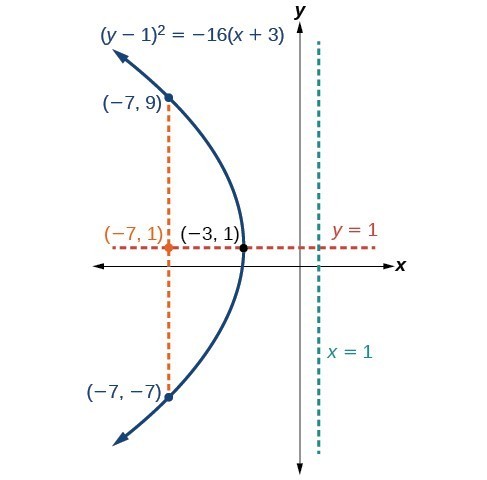
Try It
Graph [latex]{\left(y+1\right)}^{2}=4\left(x - 8\right)[/latex]. Identify and label the vertex, axis of symmetry, focus, directrix, and endpoints of the focal diameter.Answer:
Vertex: [latex]\left(8,-1\right)[/latex]; Axis of symmetry: [latex]y=-1[/latex]; Focus: [latex]\left(9,-1\right)[/latex]; Directrix: [latex]x=7[/latex]; Endpoints of the latus rectum: [latex]\left(9,-3\right)[/latex] and [latex]\left(9,1\right)[/latex].
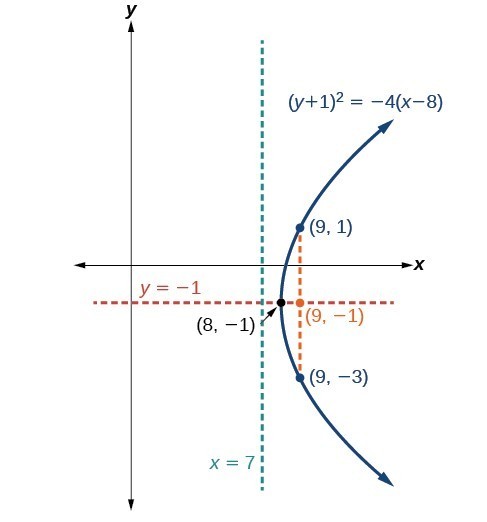
Try It
In the graph below you will find a parabola whose vertex is [latex](h,k)[/latex]. The equation used to generate the parabola is [latex](y-k)^2 = 4p(x-h)[/latex]. Your task in this exercise is to plot the vertex, axis of symmetry, focus, directrix, and endpoints of the focal diameter in terms of the free variables [latex]y,k,p[/latex]. For example, to plot the vertex, you would create a point [latex](h,k)[/latex]. https://www.desmos.com/calculator/8bj8n72isiAnswer:
https://www.desmos.com/calculator/gvpu51ti7nSolving Applied Problems Involving Parabolas
As we mentioned at the beginning of the section, parabolas are used to design many objects we use every day, such as telescopes, suspension bridges, microphones, and radar equipment. Parabolic mirrors, such as the one used to light the Olympic torch, have a very unique reflecting property. When rays of light parallel to the parabola’s axis of symmetry are directed toward any surface of the mirror, the light is reflected directly to the focus. This is why the Olympic torch is ignited when it is held at the focus of the parabolic mirror.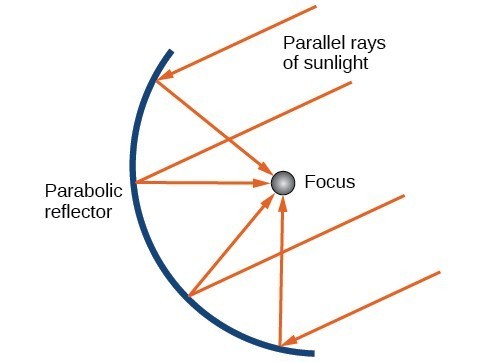 Reflecting property of parabolas
Reflecting property of parabolasExample: Solving Applied Problems Involving Parabolas
A cross-section of a design for a travel-sized solar fire starter. The sun’s rays reflect off the parabolic mirror toward an object attached to the igniter. Because the igniter is located at the focus of the parabola, the reflected rays cause the object to burn in just seconds.- Find the equation of the parabola that models the fire starter. Assume that the vertex of the parabolic mirror is the origin of the coordinate plane.
- Use the equation found in part (a) to find the depth of the fire starter.
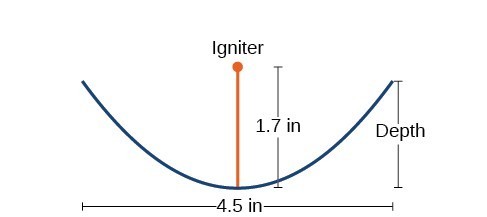 Cross-section of a travel-sized solar fire starter
Cross-section of a travel-sized solar fire starterAnswer:
- The vertex of the dish is the origin of the coordinate plane, so the parabola will take the standard form [latex]{x}^{2}=4py[/latex], where [latex]p>0[/latex]. The igniter, which is the focus, is 1.7 inches above the vertex of the dish. Thus we have [latex]p=1.7[/latex]. [latex]\begin{array}{ll}{x}^{2}=4py\hfill & \begin{array}{cccc}& & & \end{array}\text{Standard form of upward-facing parabola with vertex (0,0)}\hfill \\ {x}^{2}=4\left(1.7\right)y\hfill & \begin{array}{cccc}& & & \end{array}\text{Substitute 1}\text{.7 for }p.\hfill \\ {x}^{2}=6.8y\hfill & \begin{array}{cccc}& & & \end{array}\text{Multiply}.\hfill \end{array}[/latex]
- The dish extends [latex]\frac{4.5}{2}=2.25[/latex] inches on either side of the origin. We can substitute 2.25 for [latex]x[/latex] in the equation from part (a) to find the depth of the dish. [latex-display]\begin{array}{ll}\text{ }{x}^{2}=6.8y\hfill & \text{Equation found in part (a)}.\hfill \\ {\left(2.25\right)}^{2}=6.8y\hfill & \text{Substitute 2}\text{.25 for }x.\hfill \\ \text{ }y\approx 0.74 \hfill & \text{Solve for }y.\hfill \end{array}[/latex-display] The dish is about 0.74 inches deep.
Try It
Balcony-sized solar cookers have been designed for families living in India. The top of a dish has a diameter of 1600 mm. The sun’s rays reflect off the parabolic mirror toward the "cooker," which is placed 320 mm from the base.- Find an equation that models a cross-section of the solar cooker. Assume that the vertex of the parabolic mirror is the origin of the coordinate plane, and that the parabola opens to the right (i.e., has the x-axis as its axis of symmetry).
- Use the equation found in part (a) to find the depth of the cooker.
Answer:
- [latex]{y}^{2}=1280x[/latex]
- The depth of the cooker is 500 mm
Licenses & Attributions
CC licensed content, Original
- Revision and Adaptation. Provided by: Lumen Learning License: CC BY: Attribution.
- Graphing Parabolas With Vertex (H,K) Interactive. Authored by: Lumen Learning. Located at: https://www.desmos.com/calculator/8bj8n72isi. License: Public Domain: No Known Copyright.
CC licensed content, Shared previously
- College Algebra. Provided by: OpenStax Authored by: Abramson, Jay et al.. License: CC BY: Attribution. License terms: Download for free at http://cnx.org/contents/[email protected].
- Question ID 86148, 86124, 87082. Authored by: Shahbazian, Roy. License: CC BY: Attribution. License terms: IMathAS Community License CC-BY + GPL.
CC licensed content, Specific attribution
- Precalculus. Provided by: OpenStax Authored by: OpenStax College. Located at: https://cnx.org/contents/[email protected]:1/Preface. License: CC BY: Attribution.
